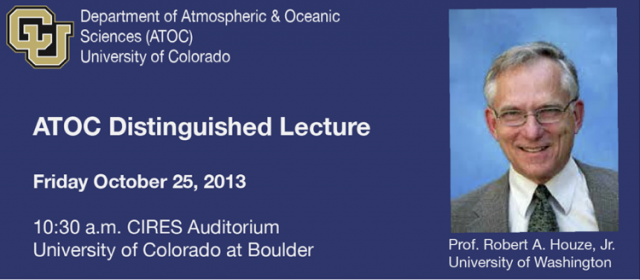
With over 200 research publications, Professor Houze has strongly influenced our fundamental understanding of cloud dynamics, cloud microphysics, precipitation processes, tropical meteorology, and radar meteorology.
He received the Carl-Gustaf Rossby Research Medal for the American Meteorological Society, is an elected Fellow of the American Association for the Advancement of Science and the American Geophysical Union, has been designated as a “Highly Cited Researcher” by the Institute of Scientific Information, and delivered the prestigious Bjerknes Memorial Lecture at the American Geophysical Union’s annual meting in 2012.
Directions to the CIRES Auditorium and information on parking.
Lecture: “Global Variability of Intense Convection” Friday, October 25, 10:30 a.m. in CIRES Auditorium.
Abstract: The A-Train and TRMM satellites have made it possible to analyze deep convection over the globe in detail. This talk will examine the behavior of the most intense convective systems around the globe as seen by these satellites. From the A-Train satellites, we have developed an objective method for identifying and characterizing mesoscale convective systems (MCSs) by combining infrared, passive microwave, and cloud radar data. Less wide and more isolated systems maximize over tropical landmasses. Larger, sometimes interconnected, mesoscale systems with wider and deeper anvil clouds occur prominently over warm tropical oceans. TRMM radar data provide more details of how deep MCSs vary over the tropics and subtropics. We have developed a methodology for using the TRMM radar data to identify different types of intense echoes, namely, those with deep convective towers, those with wide intense convective regions, and those with broad stratiform echo regions. Using these echo-type categories, we show how the population of intense convection varies relative to topography such as the Andes and Himalayas. They further allow us to determine how large-scale circulation features such as the Madden-Julian Oscillation, the Asian monsoon, and the African easterly jet control the convective population characteristics. We use precipitation estimates from the TRMM radar to determine the relative importance of each category of convective storm to climatological rainfall in key areas of the tropics and subtropics.
